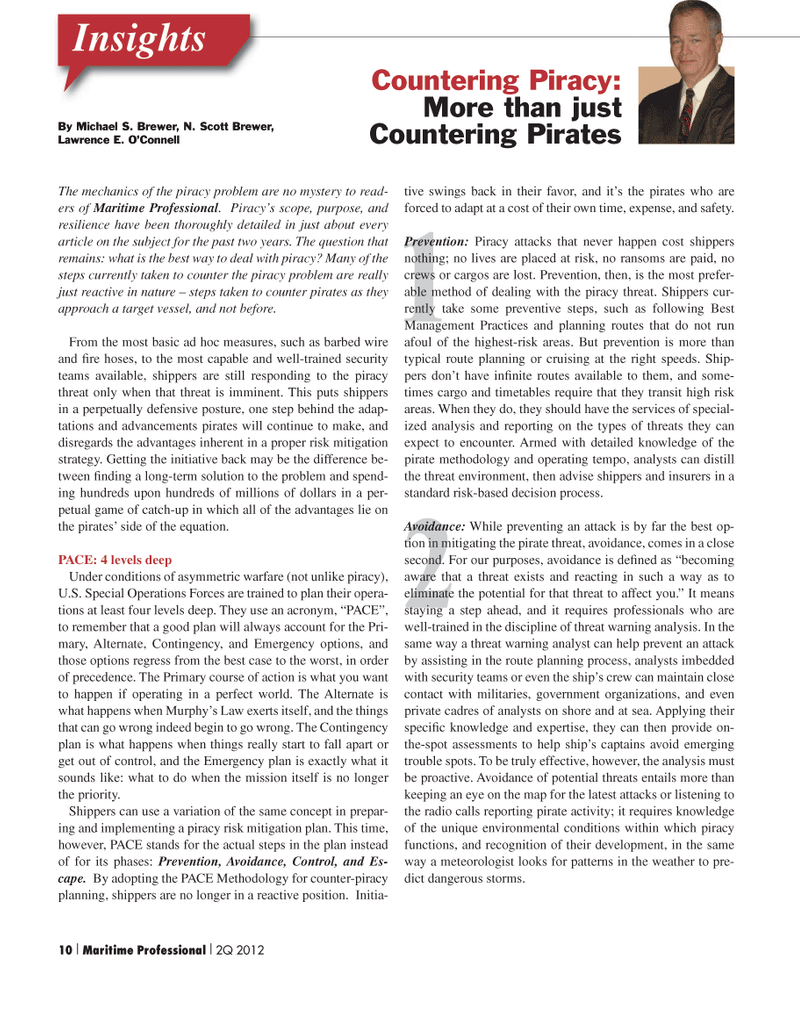
Page 10: of Maritime Logistics Professional Magazine (Q2 2012)
Maritime Risk
Read this page in Pdf, Flash or Html5 edition of Q2 2012 Maritime Logistics Professional Magazine
Insights 1 2
Countering Piracy:
More than just
Countering Pirates
The mechanics of the piracy problem are no mystery to read- ers of Maritime Professional. Piracy’s scope, purpose, and resilience have been thoroughly detailed in just about every article on the subject for the past two years. The question that remains: what is the best way to deal with piracy? Many of the steps currently taken to counter the piracy problem are really just reactive in nature – steps taken to counter pirates as they approach a target vessel, and not before.
From the most basic ad hoc measures, such as barbed wire and fi re hoses, to the most capable and well-trained security teams available, shippers are still responding to the piracy threat only when that threat is imminent. This puts shippers in a perpetually defensive posture, one step behind the adap- tations and advancements pirates will continue to make, and disregards the advantages inherent in a proper risk mitigation strategy. Getting the initiative back may be the difference be- tween fi nding a long-term solution to the problem and spend- ing hundreds upon hundreds of millions of dollars in a per- petual game of catch-up in which all of the advantages lie on the pirates’ side of the equation.
PACE: 4 levels deep
Under conditions of asymmetric warfare (not unlike piracy),
U.S. Special Operations Forces are trained to plan their opera- tions at least four levels deep. They use an acronym, “PACE”, to remember that a good plan will always account for the Pri- mary, Alternate, Contingency, and Emergency options, and those options regress from the best case to the worst, in order of precedence. The Primary course of action is what you want to happen if operating in a perfect world. The Alternate is what happens when Murphy’s Law exerts itself, and the things that can go wrong indeed begin to go wrong. The Contingency plan is what happens when things really start to fall apart or get out of control, and the Emergency plan is exactly what it sounds like: what to do when the mission itself is no longer the priority.
Shippers can use a variation of the same concept in prepar- ing and implementing a piracy risk mitigation plan. This time, however, PACE stands for the actual steps in the plan instead of for its phases: Prevention, Avoidance, Control, and Es- cape. By adopting the PACE Methodology for counter-piracy planning, shippers are no longer in a reactive position. Initia- tive swings back in their favor, and it’s the pirates who are forced to adapt at a cost of their own time, expense, and safety.
Prevention: Piracy attacks that never happen cost shippers nothing; no lives are placed at risk, no ransoms are paid, no crews or cargos are lost. Prevention, then, is the most prefer- able method of dealing with the piracy threat. Shippers cur- rently take some preventive steps, such as following Best
Management Practices and planning routes that do not run afoul of the highest-risk areas. But prevention is more than typical route planning or cruising at the right speeds. Ship- pers don’t have infi nite routes available to them, and some- times cargo and timetables require that they transit high risk areas. When they do, they should have the services of special- ized analysis and reporting on the types of threats they can expect to encounter. Armed with detailed knowledge of the pirate methodology and operating tempo, analysts can distill the threat environment, then advise shippers and insurers in a standard risk-based decision process.
Avoidance: While preventing an attack is by far the best op- tion in mitigating the pirate threat, avoidance, comes in a close second. For our purposes, avoidance is defi ned as “becoming aware that a threat exists and reacting in such a way as to eliminate the potential for that threat to affect you.” It means staying a step ahead, and it requires professionals who are well-trained in the discipline of threat warning analysis. In the same way a threat warning analyst can help prevent an attack by assisting in the route planning process, analysts imbedded with security teams or even the ship’s crew can maintain close contact with militaries, government organizations, and even private cadres of analysts on shore and at sea. Applying their specifi c knowledge and expertise, they can then provide on- the-spot assessments to help ship’s captains avoid emerging trouble spots. To be truly effective, however, the analysis must be proactive. Avoidance of potential threats entails more than keeping an eye on the map for the latest attacks or listening to the radio calls reporting pirate activity; it requires knowledge of the unique environmental conditions within which piracy functions, and recognition of their development, in the same way a meteorologist looks for patterns in the weather to pre- dict dangerous storms.
By Michael S. Brewer, N. Scott Brewer,
Lawrence E. O’Connell 10 I Maritime Professional I 2Q 2012
MP #2 1-17NEW STYLES.indd 10 5/4/2012 4:52:15 PM

 9
9

 11
11
